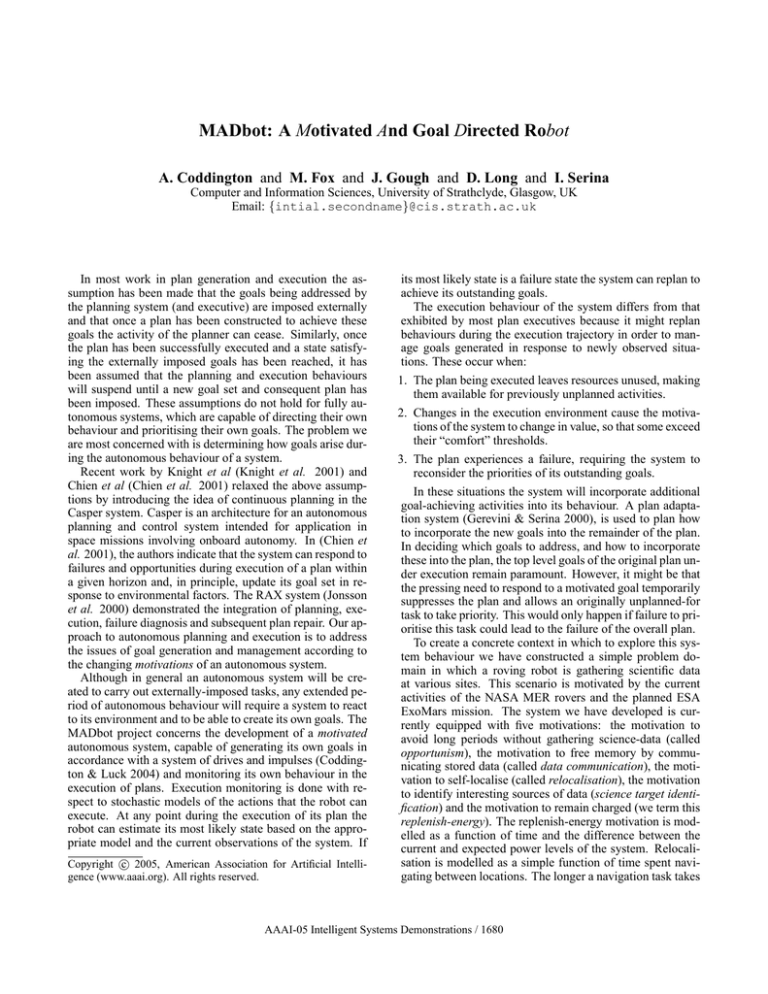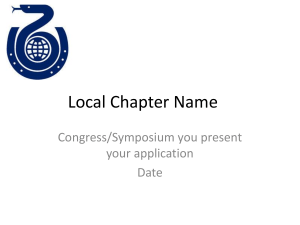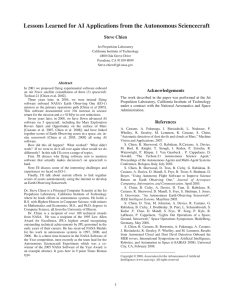
MADbot: A Motivated And Goal Directed Robot
A. Coddington and M. Fox and J. Gough and D. Long and I. Serina
Computer and Information Sciences, University of Strathclyde, Glasgow, UK
Email: {intial.secondname}@cis.strath.ac.uk
In most work in plan generation and execution the assumption has been made that the goals being addressed by
the planning system (and executive) are imposed externally
and that once a plan has been constructed to achieve these
goals the activity of the planner can cease. Similarly, once
the plan has been successfully executed and a state satisfying the externally imposed goals has been reached, it has
been assumed that the planning and execution behaviours
will suspend until a new goal set and consequent plan has
been imposed. These assumptions do not hold for fully autonomous systems, which are capable of directing their own
behaviour and prioritising their own goals. The problem we
are most concerned with is determining how goals arise during the autonomous behaviour of a system.
Recent work by Knight et al (Knight et al. 2001) and
Chien et al (Chien et al. 2001) relaxed the above assumptions by introducing the idea of continuous planning in the
Casper system. Casper is an architecture for an autonomous
planning and control system intended for application in
space missions involving onboard autonomy. In (Chien et
al. 2001), the authors indicate that the system can respond to
failures and opportunities during execution of a plan within
a given horizon and, in principle, update its goal set in response to environmental factors. The RAX system (Jonsson
et al. 2000) demonstrated the integration of planning, execution, failure diagnosis and subsequent plan repair. Our approach to autonomous planning and execution is to address
the issues of goal generation and management according to
the changing motivations of an autonomous system.
Although in general an autonomous system will be created to carry out externally-imposed tasks, any extended period of autonomous behaviour will require a system to react
to its environment and to be able to create its own goals. The
MADbot project concerns the development of a motivated
autonomous system, capable of generating its own goals in
accordance with a system of drives and impulses (Coddington & Luck 2004) and monitoring its own behaviour in the
execution of plans. Execution monitoring is done with respect to stochastic models of the actions that the robot can
execute. At any point during the execution of its plan the
robot can estimate its most likely state based on the appropriate model and the current observations of the system. If
c 2005, American Association for Artificial IntelliCopyright gence (www.aaai.org). All rights reserved.
its most likely state is a failure state the system can replan to
achieve its outstanding goals.
The execution behaviour of the system differs from that
exhibited by most plan executives because it might replan
behaviours during the execution trajectory in order to manage goals generated in response to newly observed situations. These occur when:
1. The plan being executed leaves resources unused, making
them available for previously unplanned activities.
2. Changes in the execution environment cause the motivations of the system to change in value, so that some exceed
their “comfort” thresholds.
3. The plan experiences a failure, requiring the system to
reconsider the priorities of its outstanding goals.
In these situations the system will incorporate additional
goal-achieving activities into its behaviour. A plan adaptation system (Gerevini & Serina 2000), is used to plan how
to incorporate the new goals into the remainder of the plan.
In deciding which goals to address, and how to incorporate
these into the plan, the top level goals of the original plan under execution remain paramount. However, it might be that
the pressing need to respond to a motivated goal temporarily
suppresses the plan and allows an originally unplanned-for
task to take priority. This would only happen if failure to prioritise this task could lead to the failure of the overall plan.
To create a concrete context in which to explore this system behaviour we have constructed a simple problem domain in which a roving robot is gathering scientific data
at various sites. This scenario is motivated by the current
activities of the NASA MER rovers and the planned ESA
ExoMars mission. The system we have developed is currently equipped with five motivations: the motivation to
avoid long periods without gathering science-data (called
opportunism), the motivation to free memory by communicating stored data (called data communication), the motivation to self-localise (called relocalisation), the motivation
to identify interesting sources of data (science target identification) and the motivation to remain charged (we term this
replenish-energy). The replenish-energy motivation is modelled as a function of time and the difference between the
current and expected power levels of the system. Relocalisation is modelled as a simple function of time spent navigating between locations. The longer a navigation task takes
AAAI-05 Intelligent Systems Demonstrations / 1680
External source
Goals
Goals
Goal Arbitration
(Re)Planner
State
Plan
Halt!
Motivation
Goals
State
State
Failure
Plan Dispatch
Action
Goals
Controller
Execution
Monitoring
State
Estimation
Command
Command
Sensor data
Physical System:
Actuators and Sensors
Figure 1: The architecture of MADbot. Rectangles represent components of the architecture. Ovals represent the
data types communicated between the components in the directions indicated by the arrows. The dotted line and oval indicate a Halt instruction being communicated from the controller to the dispatcher.
the more pressing the need to relocalise, until eventually the
motivation generates a goal to take a panoramic photograph,
which is intended to help to relocalise the robot. The level
of the opportunism motivation is affected by the acquisition
and communication of scientific data and the time taken over
these tasks. When the robot begins executing its plan these
functions have low values, but as time passes they increase
according to simple polynomial functions. The science target identification motivation causes the system to look for
features in its wider environment that indicate the potential
to gather interesting science. The opportunism motivation
might subsequently prompt the system to explore such features. The data communication motivation ensures the system downlinks any stored data whenever opportunities to do
so arise between planned actions in the appropriate temporal
windows.
The architecture of our system is illustrated in Figure 1.
Goals can be injected into the system from an external
source whilst others are created internally according to the
motivations. Motivations can react to the passage of time,
monitoring the perceived state over time and generating
goals if the system does not make appropriate observations
in motivation-specific intervals. Motivations can also react to state changes when they occur. The goal arbitration
sub-system decides which subset of a collection of goals
should be given priority. This decision has been explored by
other authors as the over-subscription problem (Smith 2004;
Sanchez & Kambhampati 2005), although here it is also required to account for the distinction between top level goals
(from the external source) and internal goals triggered by
motivations. The planner sub-system must face the possibility of goals changing before a plan is completely executed.
It is therefore important that it be capable of replanning to
meet a combination of new and old goals. We have adopted
a strategy based on planning by plan adaptation (Gerevini &
Serina 2000) which exploits the existing (unexecuted) plan
fragment as a starting point to seed a search for a new plan
that achieves the newly formed goal set each time the planner is invoked.
The granularity of operations is an important parameter in
the design of the behaviour of each element of the system.
It is essential that the system should not thrash, continually
replanning in response to the smallest changes in its environment but, equally, it is necessary to ensure that motivations
are capable of reacting to changes in the (perceived) state
in order to generate goals in a timely and appropriate way.
Chien et al (Chien et al. 2001) also emphasise this need for
responsiveness of the system at different levels of granularity. This partly motivates their introduction of a continuous
planning system with a shifting plan horizon.
It is important that the motivations of the system do not
interfere with its planned activities whilst these are progressing well. Therefore, the system maintains a log of its
progress, keeping track of the time and resource consumption of its actions and how these relate to the expectations
imposed by the plan. If resources become available, because
the plan was too conservative in its estimates of resource usage, the system can use the accumulated resource to satisfy
its opportunism motivation. Additional activities are only
incorporated into the plan if the system can be adequately
confident (to some probabilistic threshold determined a priori) that these additional activities will not prevent the rest of
the plan from being executable. If resources become scarce
the replenish-energy motivation of the system will increase
and the system will eventually insert a refuelling sub-plan
into the plan. The objective is to ensure that at least the expected science gains of the plan are achieved, and that they
are often exceeded because of the goals generated by the
motivation system.
References
Chien, S.; Engelhardt, B.; Knight, R.; Rabideau, G.; Sherwood,
R.; Hansen, E.; Ortiviz, A.; Wilklow, C.; and Wichman, S. 2001.
Onboard autonomy on the three corner sat mission. In International Symposium on AI, Robotics and Automation in Space.
Coddington, A., and Luck, M. 2004. A motivation-based planning and execution framework. International Journal on Artificial
Intelligence Tools 13(1).
Gerevini, A., and Serina, I. 2000. Fast plan adaptation through
planning graphs: local and systematic search techniques. In Proceedings of AIPS 2000.
Jonsson, A. K.; Morris, P. H.; Muscettola, N.; Rajan, K.; and
Smith, B. D. 2000. Planning in interplanetary space: Theory and
practice. In Proceedings of AIPS 2000.
Knight, R.; Rabideau, G.; Chien, S.; Englehardt, B.; and Sherwood, R. 2001. Casper: Space exploration through continuous
planning. IEEE Intelligent Systems 16(5).
Sanchez, R., and Kambhampati, S. 2005. Planning graph heuristics for selecting objectives in over-subscription planning problems. In Proceedings of International Conference on AI Planning
and Scheduling.
Smith, D. 2004. Choosing objectives in over-subscription planning. In Proceedings of International Conference on AI Planning
and Scheduling.
AAAI-05 Intelligent Systems Demonstrations / 1681







